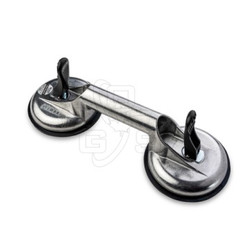How do suction cups work
Suction cups, also known as vacuum cups or suckers are versatile devices that work based on negative fluid pressure. Differences between the low-pressure cavity and atmospheric pressure create a partial vacuum facilitating the ability to lift, hold, move, and perform work. Suction cups are commonly made from rubber or plastic and are often required when dealing with applications that require lifting or handling of materials such as glass, stone (i.e. granite, marble, etc.), and insulated metal panels (IMP).
Suction cups have evolved in terms of shape, design, and composite material over the years and through this evolution are seeing increased use in various types of household and industrial applications. Consumer applications of suction cups include affixing a variety of home accessories to bathroom shower glass, tiles, and painted dry wall while industrial applications include glass lifting and manufacturing, window installation, ship building, IMP installation, and material handling in both automated and manual production line assemblies.
Whether you are lifting glass, installing insulated metal panels, moving stone slabs, manipulating materials on a production line or hanging your toiletries in the shower, you have probably run in to and used suction cups several times throughout your life. In fact, if you have ever had the joy of using a toilet plunger – you have in fact used a type of suction cup.
How do suction cups work
Suction cups rely on external pressure being greater than internal pressure. To accomplish this, a suction cup uses the negative pressure created by “pushing” out the fluid contained within the interior of the cup (cavity) and the positive pressure of the fluid trying to get back in. To help prevent fluid from “seeping” back into the cavity of the suction cup and diminishing the suction cups ability to adhere to a surface, the suction cups rim must contact the surface to create a tight seal.
The length of time it takes a suction cup to lose partial vacuum on the surface of a material / object depends on the time it takes for fluid to get between the cup and surface, equalizing the pressure with the surrounding atmosphere. This is dependent on several factors including but not limited to the porosity of the material, the quality of the cups rim, and the amount of perpendicular pulling or shear force applied.
Note: We are using the notion that any substance that flows can be considered a fluid, thus, gases, such as air, can be classified as fluids.
Buying a suction cup
Suction cups are not all created equal with some being engineered to be more effective on one surface than another. To identify the right type of hand-held suction cup or vacuum lifting device for your project it is important to consider a few key characteristics of your materials and the size or logistical constraints of your project.
Considerations
Material – Often the easiest identifiable characteristic of your project will be the material of construction. Insulated metal panels are a great example of a material consideration as standard non-porous glazing related cups may create unwanted impressions on the material or fail to create a secure bond. The type of material will often help determine the surface texture and treatments (see below) with materials like stone and insulated metal panels typically sharing rough or irregular surfaces traits as opposed to the common nonporous surface of most flat glass.
Surface Texture – A key consideration when determining the type of suction cup to use for your project is the surface texture of the material in question. Carrying forward with our example above, surface grain (ridges) on seemingly flat insulated metal panel surfaces may lead to suction cup leakage that will weaken the suction and in the case of vacuum lifting systems, put unnecessary strain on the unit. In this case, using a foam ring pad like the Wood’s Powr-Grip VPFS10T may prove beneficial as the sponge rubber seal is designed to help facilitate vacuum against rough and irregular surfaces. Additionally, materials like patterned glass adhere better to medium-flexible malleable rubber in comparison to standard rubber.
Surface –Another key characteristic of your material is the curvature or lack there-of. The essential question to ask yourself is whether your material is curved or flat. If we recall that the lack of pressure caused by expelling the fluid out of the low-pressure cavity of the suction cup keeps the suction cup adhered to the surface, it is important to note that contact between the lips of the suction cup pad and the surface is equally important. Thus, the depth of the suction cup cavity plays a vital role in its’ ability to contact the surface of curved surfaces forming a tight barrier from the seepage of atmospheric pressure. A suction cup engineered for flat surfaces typically does not take this contour into consideration, therefore the depth of the suction cup is often an indicator of the surface it was designed to perform on. Deep suction cups (i.e. 1-3/4” concavities) like that of the Wood’s Powr-Grip N6450 10” Hand Cup are typically engineered for curved surfaces.
Porosity – Porous things let things through! In the glass, stone, and construction materials industry the porosity of your material plays an important role in determining the type of suction cup best suited for the job. If a material lets water, air, or other fluids through it – it is porous. An example of porous materials includes things like concrete, wood, or various types of stone while nonporous materials are often things like glass, metal, plastics, or varnished wood.
Surface Temperature – Different materials and applications thereof can affect the surface temperature and consequently impact the decisions you make when choosing the right type of suction cup. For example, terraforming processes, or removing glass from tempering ovens often yield high heat surface areas consequently requiring a higher heat resistant compound be used on the suction cup.
Surface Treatments or Coatings – Certain materials, whether in the manufacturing process or as a post-production measure are often coated or surface treated differently. Petroleum based oils are often found on sheet and plate metals, where as low emissivity (low-e) glass coatings are commonly found in insulated glass window units. Taking the surface treatment or coatings of your materials in account is important in identifying the appropriate type of compound to use. For example, oil-resistant rubber is often best suited for sheet and plate metals, while coating-compatible rubber is designed to handle low-e glass and other coated materials without leaving markings.
Weight and Size–The lifting capacity of a suction cup is dependent on several variables including the compound of the material used on the suction cup, the surface area of the suction cup, and the atmospheric pressure to name a few. Identifying the dimensions and weight of your material, operating size restrictions, and logistical limitations of your project will aid in determining the type, size, and number of suction cups required. Any design should incorporate a safety factor greater than two.
Ontario Glazing Supplies is proud to offer an extensive line of hand-held suction cups, glass and insulated metal panel vacuum lifters, and much more from reputable manufacturers like Wood’s Powr-Grip and Bohle. For more information please feel free to visit our online store, stop by in person, or give us a call.


 Canadian Dollars
Canadian Dollars
 US Dollar
US Dollar
 Mexican Peso
Mexican Peso
 Euro
Euro
 British Pound
British Pound
 Australian Dollar
Australian Dollar
